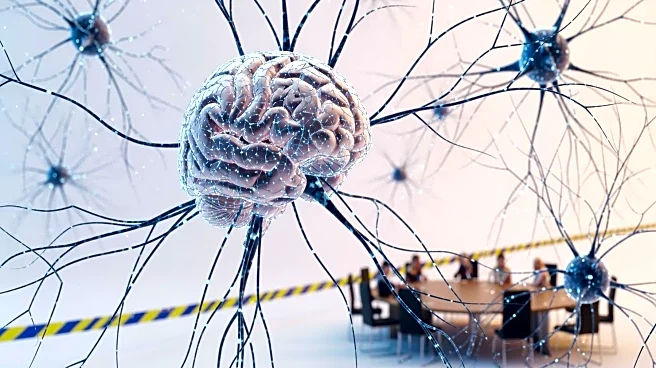What's Happening?
Recent research has introduced an intelligent 3D reconstruction and volume measurement method for white matter hyperintensities (WMHs) in patients with cognitive dysfunction. This study, conducted under
a smart healthcare framework, utilizes T2 FLAIR sequences from cranial MR images to automatically calculate WMH data. The method employs an attention-based model called Attention-Unet, which enhances the accuracy of WMH segmentation and 3D reconstruction. The study demonstrated high precision with Dice coefficient and MPA scores of over 92% on the WMH dataset. The findings suggest that WMH volume can serve as a potential risk marker for cognitive decline, especially in individuals with vascular risk factors like hypertension and diabetes. The research aims to improve early identification and intervention strategies for cognitive dysfunction, potentially reducing the incidence of dementia.
Why It's Important?
The development of this 3D reconstruction method is significant as it offers a more precise tool for diagnosing and monitoring cognitive dysfunction, particularly dementia. By quantifying WMH volume, clinicians can better assess the risk of cognitive decline in patients, allowing for earlier intervention and treatment. This approach could lead to more targeted screening processes, reducing unnecessary testing and focusing resources on high-risk individuals. The study's findings also highlight the potential for integrating artificial intelligence in clinical settings to enhance diagnostic accuracy and efficiency. This advancement could have broad implications for public health, potentially lowering healthcare costs and improving patient outcomes through early detection and management of cognitive impairments.
What's Next?
Future research will focus on refining the 3D reconstruction method and expanding its application in clinical practice. Researchers plan to conduct multicenter studies to validate the findings and improve the model's accuracy by incorporating more clinical feedback. Additionally, longitudinal follow-up studies are planned to track changes in WMH volume over time and its association with cognitive function progression. The goal is to develop a comprehensive prediction model that combines WMH data with other imaging markers and clinical indicators, enhancing the efficiency of cognitive function assessment and intervention strategies.
Beyond the Headlines
The study's implications extend beyond immediate clinical applications, potentially influencing public health policy and resource allocation for dementia care. By transforming WMH volume into a quantitative marker for clinical decision-making, the research provides a basis for risk stratification and targeted intervention, which could lead to more personalized and effective treatment plans. The integration of AI in healthcare also raises ethical considerations regarding data privacy and the need for robust regulatory frameworks to ensure patient safety and confidentiality.











